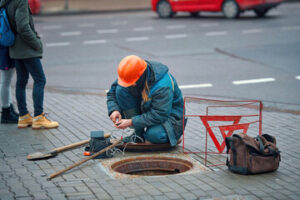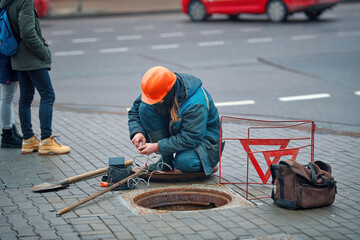A properly functioning sewer system is crucial to a home’s safety and value. However, damage to these pipes can be costly and time-consuming to repair.
Fortunately, frequent sewage inspections can prevent many of the common risky issues. This article will explore how Sewer Inspection Los Angeles works and why they’re so important.
Sewer systems are vital to the health and safety of everyone in the community. Any flaws or breakdowns can lead to wastewater and solid waste overflowing into streets, posing risks for public health. As such, maintaining these systems requires accurate and precise data. One of the best ways to gather this information is through robotic camera inspections. This innovative technology eliminates the need for personnel to enter the pipes and can be used to spot blockages, leaks, or other problems that might not be visible to the naked eye.
Robotic cameras take high-resolution pictures of the interior of a pipe, providing necessary details about its condition and structure. These images are then analyzed to identify problems and organize repairs or maintenance. This technology helps to reduce the need for invasive excavation, which is often expensive and time-consuming. As such, it offers a cost-effective and efficient solution for the maintenance of sewer systems.
In addition to the advantages offered by robotic cameras, sonar technology can also be used to provide valuable data about the condition of a pipe. In order to assess the structural integrity of a pipe, SewerVUE uses a sensor called PPR (Pipe Penetrating Radar). PPR sends out high-frequency electromagnetic waves that are reflected by the pipe walls. By analyzing the reflected energy, engineers can determine the thickness of a pipe wall and detect any defects or anomalies. PPR can even be used to see the condition of rebar in reinforced concrete pipes and detect voids forming on the outside of a pipe.
Another sensor that is used by SewerVUE is LiDAR (Light detection and ranging). This technology works by sending out a laser and measuring the time it takes for the signal to reach the target and reflect back to the sensor. It can then generate a three-dimensional model of the pipe’s inner surface, including dimensions and depths. This allows SewerVUE to identify and locate problems such as deteriorating pipe materials, misaligned joints, and obstructions in partially surcharged lines.
For a recent project in Hong Kong, SewerVUE used a combination of CCTV with PPR and LiDAR to inspect a 7km long sewer tunnel. The results showed that despite the muddy conditions, the tunnel was in good condition with only minor structural defects. This allowed the client to submit an accurate bid for repair and maintenance, avoiding costly change orders.
Cameras
Your plumbing system does a lot of work behind the scenes: it delivers fresh water to points throughout your home, drains wastewater and eliminates sewage. That’s why it is so important to maintain the integrity of these pipes. During a sewer line inspection, plumbers use a special camera to get a closer look at your pipes.
This allows them to spot problems like cracks, holes, obstructions and infiltration. It also helps them determine the best course of action for repair and replacement. A camera inspection is particularly useful for older pipes made of clay or cast iron, which are prone to breaking down and developing leaks over time.
A plumber will typically insert the camera into your home’s cleanout pipe, or a cleanout line in the yard. This is a pipe that leads to the city sewer line or your septic tank. The camera is then guided through the pipes, identifying any issues and giving the contractor a clear view of the interior of the lines.
The quality and features of a sewer inspection camera vary, but most are designed to withstand wet and dark environments. They may have HD capabilities, wide-view fish-eye lenses for side-scanning or pan/tilt functionality. They are able to record video inside pipes that can be streamed live or recorded for later review.
If a clog or other problem is identified, the plumber can use the camera to determine what kind of snake or water jet will be necessary to remove the blockage and restore flow. The camera will also help the plumber decide whether a full line replacement is required or if a more affordable repair option would be suitable.
Homeowners often request a sewer inspection before listing their home, as it can alert potential buyers to any issues that need fixing. They can then have the repairs done before putting the house on the market. It is also a good idea to have a sewer line inspection before you add a new bathroom or kitchen, or even remodel an existing one. The added strain on the pipes can cause them to break down or develop leaks.
Access Points
Most homeowners don’t think about the condition of their sewer line until something goes wrong. If your toilets are constantly clogging or the grass in your yard is suddenly green even though you don’t water it, these are all signs that your sewer line needs attention. Getting a professional to inspect your sewer line can save you from expensive repairs down the road.
During a sewer scope inspection, professionals use a camera to evaluate the conditions of your sewage pipes. Performing this evaluation without damaging your plumbing system is a challenge, but modern technology has made it possible. Professional inspectors start by locating an access point to the sewer pipe. This is usually a sewer cleanout or the main house sewer trap. Using these existing points allows the inspector to enter and explore the pipeline without any messy excavation.
Once the inspector finds an entry point, they insert the camera into the pipes. As the camera moves, the technician observes the live feed on a monitor and documents any issues they find. This documentation will be included in the final inspection report for the homeowner.
Modern video cameras can travel a long distance down your sewer pipes, making them useful for assessing the overall condition of the line. The inspector will be able to see any obstructions or damages that are causing problems, such as broken or cracked pipes, root intrusion, and blockages. The inspection also provides valuable information about the size and location of your sewage pipe, which can be helpful in planning for future repairs.
The inspection process also involves identifying the type of material your sewer pipes are made from. This is important because different types of pipes have varying costs and durability. In addition, a knowledgeable inspector will be able to advise you on whether your pipes need to be replaced or can benefit from a re-lining service.
A sewer scope inspection should be a standard part of every homebuyer’s due diligence process. Unfortunately, many buyers neglect this crucial step, either because they don’t realize the importance of a quality sewer inspection or because they rely on a seller-provided home inspection report. Fortunately, a qualified home inspector can perform both a general home inspection and a detailed sewer scope for you, so you can make an informed decision about the property you’re considering.
Reporting
Modern sewer inspections rely on cutting-edge technology and specialized tools. One of the most important pieces of equipment is a camera, which provides live video footage of the interior of pipes. This allows inspectors to identify problems such as clogs, cracks, and more. The camera also helps to locate the source of a problem, which can save valuable time and money.
To begin the inspection process, a professional plumber will locate suitable entry points into the sewer system. These may include maintenance holes, cleanouts, or other marked entrance locations. Once the access point is located, a small rod with a camera attached to it will be inserted into the line. The camera is able to move through the entire length of pipes, allowing inspectors to see the condition of all components and any potential issues that may exist.
Once the camera is fully inspected, a full report will be prepared. The report will detail the findings and provide recommendations for next steps. The report will also note any areas of concern, such as a sagging area in the pipe that is likely to cause a blockage. The report will also include a list of potential repairs and their estimated cost.
In addition to identifying any potential issues, the report will provide detailed information about the condition of pipes and other sewer components. This includes a description of the material used to construct the pipe, its size, and any defects or damages. It will also list any other notable features of the sewer system, such as sagging areas or unusual noises.
As the world’s urban populations grow, the longevity and efficiency of sewer systems will depend on regularly scheduled inspections and cleanings. By using cutting-edge technologies and expert personnel, sewer inspections can help to reduce the risk of costly and disruptive failures.
